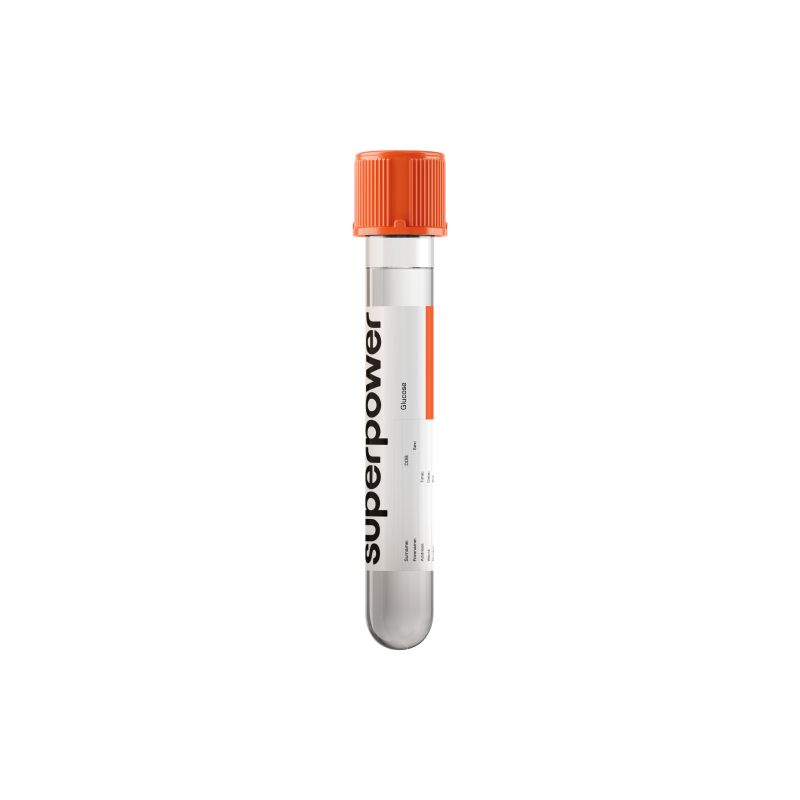Glucose testing shows how effectively you regulate fuel for your brain, muscles, and organs.
By understanding your glucose balance, you can optimize daily energy, prevent long-term health risks, and tailor nutrition, training, and recovery.
Key Benefits
- See your current blood sugar level to screen for diabetes and prediabetes.
- Spot early sugar imbalance before symptoms, enabling prevention and timely follow-up.
- Clarify causes of fatigue, thirst, blurry vision, or frequent urination from high sugar.
- Guide lifestyle and medication choices to reach safe glucose targets.
- Flag higher heart, kidney, and nerve risks linked to chronic high glucose.
- Protect fertility by uncovering glucose issues that disrupt ovulation, especially with PCOS.
- Support pregnancy by screening for gestational diabetes and guiding monitoring throughout.
- Track trends and pair with A1c for short- and long-term glucose insight.
What is Glucose?
Glucose is the body’s main simple sugar, a small carbohydrate molecule that circulates in the blood (a monosaccharide). It comes from three sources: digestion of dietary starches and sugars in the intestine, release from stored carbohydrate in the liver (glycogenolysis), and new production by the liver and kidneys from other nutrients (gluconeogenesis). After a meal, the gut absorbs glucose into the bloodstream and delivers it to tissues.
Glucose is the primary fuel for most cells and is essential for the brain and red blood cells. Cells take it up through specific transport proteins; in muscle and fat this uptake is promoted by insulin. Inside the cell, glucose is broken down to make energy for cellular work (ATP via glycolysis and oxidative metabolism) or stored as glycogen, and excess can be converted to fat (lipogenesis). The concentration of glucose in blood reflects the moment-to-moment balance between intake, storage, release, and use, coordinated mainly by insulin and its counter-hormone glucagon. In this way, glucose links what you eat to the energy needs of your organs, keeping metabolism steady between meals and during activity.
Why is Glucose important?
Glucose is the body’s primary fuel for brain, muscle, and immune cells. Blood glucose shows how well insulin and its counter‑hormones move energy from food and the liver into working tissues—a real‑time readout of whole‑body metabolic balance.
Fasting values typically run 70–99; 100–125 signals prediabetes, and 126 or higher on repeat testing indicates diabetes. After meals, healthy peaks stay under 140; “optimal” sits mid‑range fasting with brief, modest rises after eating. Children tend to run slightly lower; pregnancy uses tighter thresholds.
When values fall, adrenaline and glucagon surge while the brain is under‑fueled. This can bring shakiness, sweating, palpitations, hunger, confusion, blurry vision, or seizures if severe. Common drivers include excess insulin, prolonged fasting or strenuous exercise, and less often liver disease, alcohol, or adrenal/pituitary failure. Children deplete glycogen faster, and insulin‑treated pregnancy raises risk.
When values run high, insulin is insufficient or resisted, so glucose lingers in blood and injures vessels and tissues. Thirst, frequent urination, fatigue, and blurred vision are common; over time, elevations inflame and scar the kidneys, cloud the retina, numb nerves, and strain the heart. In pregnancy, high glucose increases fetal growth and delivery risks.
Big picture, glucose sits at the crossroads of metabolism, linking pancreas, liver, muscle, fat, brain, and blood vessels. Its patterns travel with weight, lipids, blood pressure, sleep, and inflammation, shaping long‑term risks for diabetes, cardiovascular and kidney disease, and cognitive decline.
What Insights Will I Get?
Glucose is the concentration of sugar in blood—the brain’s primary fuel. It reflects the balance of intestinal absorption, liver output, and insulin‑driven uptake. As a core energy signal, it indicates metabolic flexibility and resilience; chronic imbalance influences cardiovascular, cognitive, reproductive, renal, neural, and immune health.
Low values usually reflect excess insulin relative to supply, depleted glycogen, or weak counter‑regulation (low glucagon/epinephrine, adrenal or pituitary insufficiency). Systemically this deprives the brain of fuel (neuroglycopenia), provokes adrenaline symptoms, and can blunt mood, attention, and exercise capacity. More common in infants and children with small glycogen stores; can occur in pregnancy with prolonged fasting or vomiting.
Being in range suggests appropriate insulin sensitivity and hepatic output, with intact glucagon, cortisol, and growth‑hormone responses. It supports steady energy, clear cognition, and vascular stability; for fasting values, risk is usually lowest in the lower third of the reference interval without dipping low.
High values usually reflect insulin resistance, inadequate insulin secretion, or excess stress hormones (illness, pain, steroids). In pregnancy, placental hormones raise insulin resistance; persistent elevation suggests gestational diabetes. System‑level effects include osmotic diuresis and dehydration, endothelial injury and protein glycation, impaired immunity and wound healing, and progressive kidney, retinal, and nerve damage.
Interpretation depends on fasting status, time since eating, acute illness, sleep loss, and recent exercise. Capillary and venous values can differ; delayed processing lowers measured glucose. Older adults often run higher at a given insulin level; children vary more with illness.



.svg)



.png)
.png)
.png)
.png)








